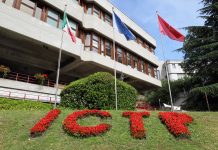by Nina Vaclavikova
Interview: FVG councilor for safety, Pierpaolo Roberti; Trieste councilor for urban works, Elisa Lodi
The city of Trieste is ushering in a new chapter for the historic Piazza Sant’Antonio, delivering tangible progress on its comprehensive restoration, fuelled by fresh funding from the Friuli Venezia Giulia region.
At a site visit and press briefing this morning, Mayor Roberto Dipiazza, together with Elisa Lodi, the councilor overseeing real estate policy, detailed updates on the redevelopment. Alberto Polacco attended on behalf of councilor Michele Babuder, joined by public works officials and regional councilor Pierpaolo Roberti.
“Today marks the completion of the first segment of a significant public initiative,” Mayor Dipiazza declared. He expressed gratitude toward the regional government and noted that the chosen stonework harmonizes with designs featured in Piazza della Borsa, Piazza Verdi, Via Cassa di Risparmio, and Via Torino. “We will continue the project with equal care in selecting pavement materials tailored to each area,” he added.
Councilor Lodi underscored the value of regional collaboration. “This was one of the final urban squares pending redevelopment,” she observed. “Today’s outcome is very encouraging for both local merchants and residents. The upgraded side streets, Via Ponchielli and Via Paganini, were developed at a cost exceeding €780,000. Work now shifts to redeveloping the square’s forecourt using €1 million set aside by the municipal council. A new regional funding package worth €2.3 million will then enable renewal of the entire piazza.”
Lodi further emphasized the strategic approach: “Such resources underscore the importance of sustained discourse with higher-level entities to realize ambitious goals. In Piazza Sant’Antonio, our administration — my office and that of Councilor Babuder — is executing a conservation-focused redevelopment aligned with public sentiment and in close coordination with cultural heritage authorities.” She also noted that the region’s support is part of a broader initiative extending beyond the city center, including investments in sports infrastructure.
Allocation of Funds
| Purpose | Amount (€) |
|---|---|
| Phase One (municipal) | 780,560 |
| Phase Two (city reserves) | 1,000,000 |
| Full Project (regional) | 2,300,000 |
Master Plan Highlights
The redevelopment aims to weave visual and functional continuity between the Canal Grande and the Church of Sant’Antonio, encompassing the square, central garden, Via Paganini, Via Ponchielli, and parts of Via della Zonta. Its design principles include creating a level, step-free space, invoking the area’s historical layers, restoring canal boundaries through archival references, and preserving green elements.
Phase One: Via Paganini and Via Ponchielli
This initial stage involved overlaying side streets with new sandstone slabs mirroring the dimensions of traditional masegni stones. Reclaimed original stones were unavailable due to limited supply, and prior reserves were already allocated for other projects. Updates also included modern linear inlets for efficient rainwater drainage. Work kicked off in autumn 2024 following utility upgrades by AcegasApsAmga Spa, financed partly by national PNRR funds, with completion expected by summer 2025.
Phase Two: Church Forecourt
The focus now shifts to the area in front of the church. Masegni unearthed during site preparation will be used centrally, aligned with the former trajectory of the Ponterosso canal and nearby axes of Via Dante and Via Trenta Ottobre. Side extensions will continue the sandstone pattern used in Phase One, while large slabs will delineate the canal’s historic banks—a motif visible in the Via San Spiridione–Via Filzi redevelopment. To distinguish heritage-driven features, a contrasting chiseled stone like aurusina, as mandated by cultural authorities in March 2023, will mark the former canal’s trace.
Phase Three: Garden and Fountain
The final phase involves refurbishing the central green space and fountain area, with harmonized stone finishes and updated stormwater infrastructure. Existing drainage systems will also receive necessary inspections and enhancements.




























